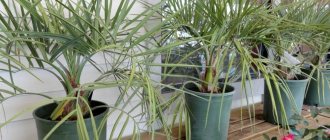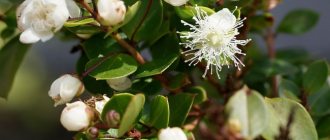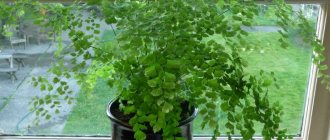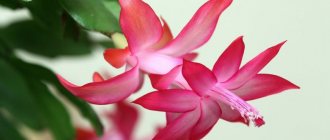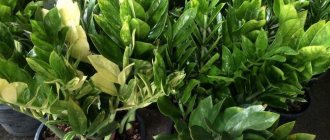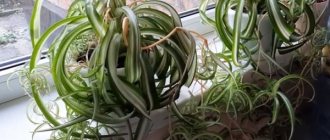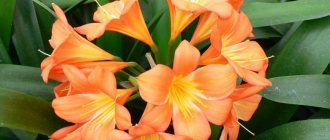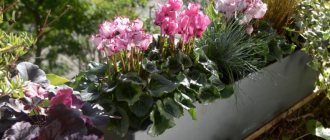Aichryson is also called the “ tree of love ”. It is directly related to the genus of succulent plants, which are part of the Crassulaceae family. This plant prefers to grow in rock cracks. In nature, it can be found in the Canary and Azores Islands, Madeira, Portugal and Morocco. This genus includes 15 species, among which there are herbaceous perennial and annual plants and subshrubs. The name of such a flower is derived from 2 Greek words, namely: ai - “always” and chrysos - “golden”. Aichrizon has a clear resemblance to its closely related money tree.
The shoots of Aichrizona are partially branched and almost never lignify. The oppositely arranged fleecy leaves have a rounded-ovate shape, and they are collected in leaf rosettes. The color of the leaf blade is dark green or green, sometimes there are splashes of yellow, white, gray and red. A damaged leaf blade emits a not very pleasant odor. The leaves are heart-shaped, which is why this plant is called the “tree of love.” Paniculate or corymbose inflorescences consist of small star-shaped flowers that can be white, red or cream in color. Flowering occurs in April or May. After the plant has flowered, its leaf rosette, which produced the peduncle, dies. At home, aichrizon is grown as a standard tree or a simple bush.
Domesticated species
Not all aichrizones were able to take root in indoor conditions. You can even determine whether your succulent belongs to a specific species by the description of the flower, because all plants of this species have significant external differences from each other. The most common ones are the following:
Aichrizon home
The most popular selection hybrid among gardeners. The height and diameter of the crown are approximately equal and usually do not exceed 30 centimeters. It has small leaves, similar to the heads of pins, and is almost always covered with sparse whitish hairs. The flowers of this species are bright yellow.
Aichrizon sedum-leaved
It is extremely branched, stretching upward rather than wider; the difference between the height and diameter of the crown is usually twice as high in favor of the first indicator. The foliage is slightly sticky, light green with a light green or even yellow tint. The flowers are golden yellow.
Aichrizon is loose, it is also prostrate
Height up to forty and diameter up to thirty centimeters. The foliage is diamond-shaped, almost completely falling off after flowering. There are a lot of flowers themselves: clusters of cream, some yellowish flowers can stretch up to twenty centimeters in length.
Aichrizon sinuous
Creeping subspecies. With a small height, barely reaching 15-20 centimeters, the crown area occupies about 30-40 centimeters. The surface of the succulent is covered with short fluffy hair.
Aichrizon point
A subspecies up to thirty centimeters high, the leaves are dark green in color and covered with light fibers. There is less fluff on the leaves, but they also have it. The edges of the leaves are covered with small teeth.
Despite the noticeable external differences, all varieties of aichrizon require the same conditions of maintenance and care indoors.
What does the tree of happiness look like: a description of the plant and its root system
The indoor decorative foliage plant reaches a height of no more than 15-20 cm. The life span of the flower is long, and the growth rate is average. Its root system is superficial and partially underdeveloped. The stems of aichrizon are usually brittle, partially branched and woody at the base.
Depending on the type, the leaf blades are diamond-shaped or heart-shaped with slight pubescence.
They are oppositely located, fleecy and collected in small rosettes. The color of the plates is usually dark green, sometimes there are red, gray, white or yellow inclusions. Important ! Damaged leaves emit an unpleasant aroma.
Lighting
Aichryzons love plenty of light, but direct sunlight can burn the fleshy leaves of a succulent. Therefore, the optimal solution would be to organize diffused light with a duration of about fourteen hours.
For uniform development of the crown, it is necessary to periodically change the position of the plant, exposing it on different sides to the light source.
Table: Microclimate for keeping a flower
At home, aichrizon learned to survive in extreme conditions. Therefore, even “in captivity” he is very unpretentious. But flowering occurs only if the plant is provided with the correct microclimate.
| Factor | Recommendations |
| Location | Window facing northeast or northwest. On the north side there is not enough light for growth and development, not to mention flowering. When placed on window sills in a different direction, shading is required (in spring and summer). To ensure that the crown takes the correct shape, the pot is turned slightly weekly (by about 10–15º). Move the flower at least 1.5–2 m away from operating heating devices and other heat sources. |
| Lighting | The light is bright, but diffused. To protect from direct sunlight, a paper screen, gauze or curtain is sufficient. |
| Temperature | During the active growing season - 20–25°C. The flower will tolerate heat above 30°C, but can “hibernate”, stopping growing and becoming bald. During winter holidays - 8–10°C. Wintering in a warm place greatly worsens the appearance of the airborne area. The plant will not survive negative temperatures. |
| Air humidity | Dry air is not a problem for the airborne zone. In extreme heat, you can place a bowl of water next to it and cover the soil with damp expanded clay, peat, or moss. Hairy species cannot be sprayed. |
If it is not possible to place the aichrizon in winter on an unheated loggia, in a greenhouse, winter garden or other place with a suitable temperature, place it as close to the window as possible, placing some heat-insulating material (for example, a piece of polystyrene) under the pot. This will protect the roots from the heat coming from the radiators located under the windowsill.
Temperature and humidity
For most of the year, the plant feels comfortable at room temperature. In winter, in order to create a period of necessary rest for the plant, it is recommended to move it to an area with +10-12 degrees.
It is important not to let this indoor plant get cold; to do this, you need to make sure that the temperature does not drop below 8 degrees. At the same time, during wintering, watering is reduced to zero; only once every few days it is recommended to carry out surface spraying of the soil.
In general, aichrizon prefers dry air, so it does not need spraying or moisturizing. However, it is permissible to give the plant a warm shower once every couple of weeks; this will have a positive effect on the appearance of the succulent.
Plant care
Aichrizon at home is not particularly difficult to care for. By following simple maintenance rules, you can get an almost evergreen and long-flowering tree. The indoor plant aichrizon compares favorably with the rest of the home flower garden in its shape, size, appearance, and abundant flowering. Even novice flower growers can easily figure out how to care for the tree of happiness so that it always brings only pleasant emotions and is a symbol of goodness and love.
Air humidity
Aichrizon is absolutely indifferent to air humidity; additional spraying of leaves is not required. However, a warm shower for the plant during the hot season will not hurt at all. Any water procedures during the rest period are strictly contraindicated.
Top dressing
For good growth and abundant flowering, the plant must be fed with complex fertilizers with a low nitrogen content. The fertilization period is in spring - summer. The frequency of feeding is no more than 2 times a month.
Watering
The plant does not tolerate excess moisture in the soil, as a result of which in the spring and summer the bush is periodically watered little by little, approximately once every 3 days. Between waterings, the soil in the flower pot should dry out by half.
How do you know that a plant needs water? It’s very simple - if the leaves and trunk are elastic and strong, then the plant has enough water and no additional watering is required. If the leaves and stems become soft and limp, the aichrizon needs watering. Rare but abundant watering can lead to stagnation of water, as a result of which the root system can begin to rot.
Temperature
During the flowering period, the ambient temperature should be between +23...+25°C. In winter, during the dormant period, the pot with the plant must be moved to a room with a temperature of +10°C. If the temperature regime is violated during the wintering period, when the air temperature exceeds the recommended value, the plant sheds its leaves and the stem stretches.
Central heating radiators have a detrimental effect on the well-being of the tree. To reduce the degree of drying out of the soil, during the heating season, the flower pot is placed on a high wooden or foam block.
Lighting
The light-loving plant prefers bright, diffused light, without direct sunlight. The best location for a flower pot will be window sills on the east and west sides; on the south side you will have to take care of creating a little shading. For good growth, the optimal exposure to light should be 12-14 hours. In this case, you should periodically turn the pot so that the tree develops, grows and receives sunlight evenly.
The soil
The plant is undemanding to the composition of the soil; for good growth it is recommended to select well-fertilized soil with a high content of sand and turf. Specialized flower shops sell special soils for succulent plants; a soil mixture for cacti is also good. Some gardeners have successfully grown aichrizon in vases with hydrogel.
Trimming
To create a neat crown of the required shape, the plant is pruned. Weak, limp branches and leaves are removed. For lush growth of leaves, pinch the tops of young shoots. After a dormant period, elongated shoots are cut to the required length.
Rest period
After flowering there comes a time of rest, which occurs in the autumn-winter period. The beginning of hibernation is characterized by complete or partial loss of foliage. At this time, the pot with the plant is removed to a room with a temperature of about +10°C. A glass balcony or outdoor greenhouse is perfect for this. Watering is reduced to three times a month.
Possible difficulties
If not properly cared for at home, aichrizon may wither, shed leaves, or even die. In order for the plant to feel good, it is necessary to choose a watering regime in which the soil is not too moist, but not too dry. If this regime is not followed, the plant will quickly lose its bright, healthy, unusual appearance.
The main difficulty in growing is the loss of foliage. A review of the irrigation regime and the introduction of additional fertilizer will help solve it. Many people do not remove excess foliage and overgrown branches. With all this splendor of the “green dome”, the trunk can suffer greatly from this, since it can simply break under the weight of twigs and leaves.
Soil selection and replanting
Aichrizon will ideally thrive in ready-made soil mixed specifically for succulents and cacti. Such soil will satisfy all the needs of the plant.
With proper care, aichrizon develops quickly, and it needs to be transplanted into a new container approximately every two years. The procedure should be carried out in early spring, before the plant emerges from winter dormancy.
It is necessary to add drainage to the pot, and only after that the main soil should be added, slightly moistening it. After removing the succulent from the old pot, sanitary pruning is carried out if necessary.
After transplantation, the plant should be left outdoors for a couple of days, but the first watering should be done no earlier than five days after transplantation. The first month after changing the pot, you should water the plant with caution so as not to create conditions for the development of root rot.
Pests and diseases
The aichrizon flower can be affected by rot. If the roots begin to rot, then remove the flower from the pot, trim them to healthy places, place them in a solution of potassium permanganate, then sprinkle with crushed coal. Then replant it in a new pot with fresh soil.
Aichrizon can be attacked by spider mites or mealybugs.
If this happens, first wash the leaves with soapy water.
Next, spray with Actellik and Fitoverm.
If the leaves wrinkle and lose turgor, this means that they do not have enough moisture. If the stems are elongated and faded, then they do not have enough lighting.
The leaves of the flower rapidly fall off: due to direct rays of the sun, excess moisture, and air temperatures in winter that are too high for the flower.
If there is excess moisture, the flower rots. If brownish or yellowish spots appear on the leaves, this means that the plant has been burned by the sun's rays.
plant does not bloom if it does not have enough light .
Watering
During the period of active growth, the aichrizon plant requires regular, but not extensive watering. Between adding moisture, the soil should dry out to the middle of the pot, but a more obvious sign is the leaves of the plant.
Experienced flower growers understand when and how to water a flower based on their condition. When a succulent lacks water, the leaves lose their elasticity and become wrinkled. Typically the plant requires watering every 4-5 days.
Magical properties of the plant
According to superstitions and signs, the tree of love has the following properties:
- creating an aura of happiness, peace, harmony and a romantic atmosphere in the home;
- energy improvement;
- increase in strength;
- neutralization of negative energy;
- protection of home and family members from harm and disease;
- increased mutual attraction;
- establishing the necessary mutual understanding between loved ones and lovers;
- building relationships and strengthening marriage.
Attention! The tree of love can exhibit its magical properties only with adequate care in compliance with all requirements.
People need to learn to pay attention not only to signs, but also to mutual respect in order to avoid troubles in married life.
Breeding
There are two methods to grow new specimens of succulents: through cuttings and through seed germination. When choosing a method, it is worth considering that plants obtained by cuttings develop much faster than their counterparts from seeds.
Propagation by seeds
As soil for planting seeds, you must use a mixture of leaf soil and sand, in a ratio of 2 to 1. Immerse the seeds to a depth of no more than half a centimeter and leave the container in a warm place, covering it with film or glass to create greenhouse conditions. It is necessary to regularly ventilate the pot and moisten the soil with a spray bottle.
Shoots will appear in about 14 days. The sprouts must be transplanted into a new container after they have formed 3-4 leaves, after which they can no longer be covered. When the succulents get stronger, you should plant them in separate pots and care for them as you would for adult plants.
Cuttings
Cuttings are done at the very beginning of spring. For it, shoots at least 9 centimeters long are selected, carefully cut and dried in the shade for several hours. There are two methods for rooting.
You can immediately plant the cuttings in the soil, or you can first soak the sprouts in water with activated carbon dissolved in it, waiting until the first roots appear. Once the seedlings take root, they can be planted in their own pots.
Detailed description
Homeland, history of breeding
Aichryson prostrate (lat. Aichryson laxum) has several other names - Aichrison loose, Sedum loose, Aeonium prostrate. It grows in rock crevices because it does not tolerate wet soils and excess water. It gets the amount of moisture it needs from precipitation and fog.
This is a perennial plant that grows naturally in the Canary and Azores Islands, as well as Madeira. Succulents of this genus are also called the Tree of Love.
Size, type
Aichrizon refers to succulent plants that have special tissues that store water. An adult succulent looks like a small dwarf tree about 30-40 cm high.
Stem, leaves, flowers
The stem is erect, strongly branching into lateral branches, forming a cubic crown.
The foliage is located on long petioles. The leaves are diamond-shaped and resemble a heart, which is why the plant is called the tree of love. The color of the leaves depends on the lighting - in the sun they become brownish-green, in the shade they acquire a rich green color. There is hair pubescence on all leaves , giving a grayish-silver coating. The foliage at the ends of the branches forms rosettes, from which grow small and numerous yellow flowers on short red pubescent pedicels.
Important! After flowering, the plant may die.
Common Problems
Falling leaves
In most cases, the loss of leaves by aichrizonas should not be perceived as a negative symptom. After flowering, the succulent sheds its leaves, and this is a normal stage of its development. You should only be concerned when the leaves fall during the winter dormant period: in such a situation, it is necessary to reconsider the conditions of maintenance.
Root or stem rotting
If putrefactive processes develop, the plant cannot be saved. All that remains is to separate the branches suitable for cuttings and start nurturing them.
Blisters on leaves
Blisters swollen on the leaves are the so-called “white swelling”. The phenomenon occurs due to errors in care, in which excess moisture does not have time to evaporate through the leaves and literally tears their structure from the inside.
To prevent the development of this pathology, it is necessary:
- Thin out the fruit planting;
- Do not water the plant in cold and damp weather;
- Improve drainage in the pot;
Choose a fertilizer with a high calcium content.
Pests
Most often, succulents are affected by spider mites and scale insects. It is worth adhering to the standard treatment regimen: quarantine from other plants and repeated treatment with insecticides.
Like many other plants that are exotic to our latitudes, aichryzons only seem difficult to care for. In fact, if you follow the rules of watering and properly organize the dormant period, even a novice plant lover can cope with growing them at home.
Flowering aichryzon
If you create favorable conditions for life - a pot of suitable size, cool wintering, not too frequent watering - the aichrizon will definitely thank you and bloom with red or yellow panicles. Typically, flowering begins in April-May and continues until September-October.
Do not be alarmed that as the flowering process progresses, the bush will begin to shed its leaves. This is a natural process. After flowering, remove flower stalks and weak stems, and reduce the intervals between watering. In addition, fertilize. In this case, the Tree of Love will quickly restore lost strength.
If you think the leaf fall is too strong, you can trim off some of the old shoots.
Photo of the plant Aichrizon (Tree of Love)
Signs and superstitions about the aichrizon flower
A tree of happiness or love is grown to maintain harmony and a good psychological microclimate. According to signs, aichrizon helps to detect the slightest changes in the relationship between spouses and loving people.
The appearance of flowering is a good sign, indicating harmony. The withering of the aichrizon speaks of tension between spouses.
There is a sign about fallen leaves or branches of aichrison. Keeping withered leaves of the tree of love in the house means attracting poverty. The couple expects a decrease in feelings and love. For this reason, they need to be disposed of in a timely manner.
Esotericists claim that the condition of the plant can be a sign of a partner’s betrayal. A breakup can be avoided through proper care and improving relationships at all levels. The resumption of flowering is a good sign.
The Love Tree helps couples who are not moving to a new stage in their relationship decide on their plans. Intense flowering is a sign of a wedding. The poor condition of the plant indicates the need for separation.
Airhrizon can be started by single people. The lush blossoming of the tree of love foreshadows the creation of a family. The sign says that if the plant reacts well to the chosen one, this person is the other half. The sudden wilting of aichrizon indicates a wrong choice.
Reproduction
To propagate the plant, you need to carefully cut the cuttings, keep them in a cool, dry place for several hours, and then plant them in damp sand (soil mixture for succulents).
The easiest way to root aichrizon is by cuttings. Before planting in regular soil, it is better to apply fertilizer with a fungicide to prevent fungal diseases.
Rooting cuttings in water is a little more difficult, since there is a high probability that they will rot due to excess moisture. Cuttings germinate better than seeds.
Reproduction by seeds is also possible. You just need to remember that sprouts appear after about 3 weeks. For seeds, take small bowls, sow them in a mixture of sand and soil, cover with glass or polyethylene. The sprouts need to be ventilated daily.
After germination of the sprouts for 3 weeks, they need to be planted from small containers into larger ones at a distance of 1 cm from each other. Keep seedlings in a bright place at a temperature of + 16 + 17 ° C.

